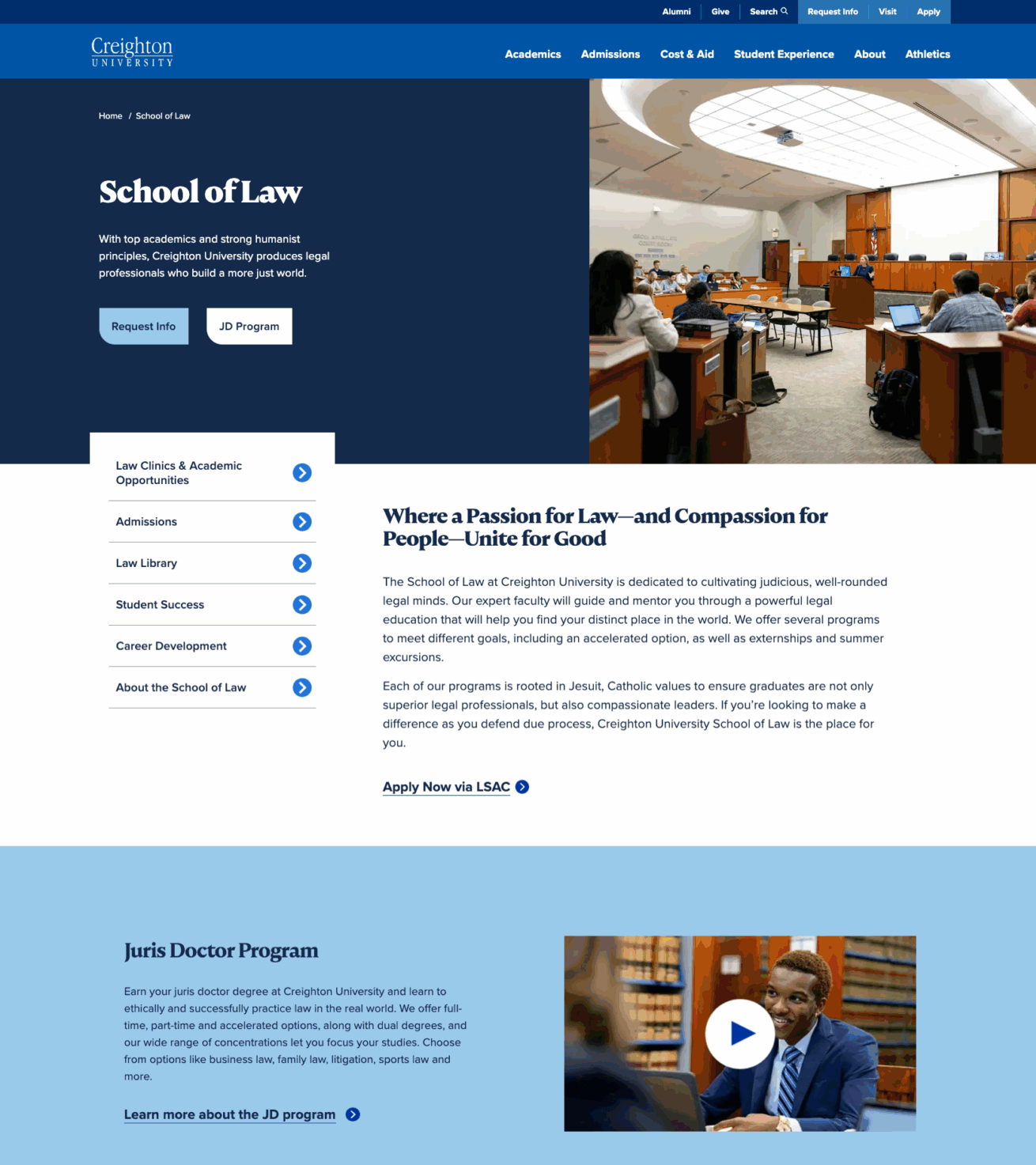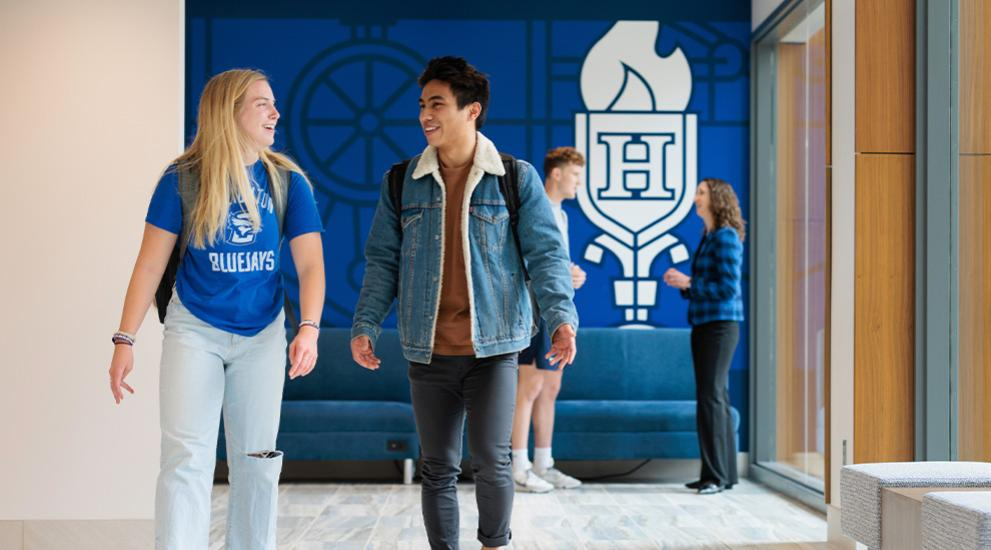Nuts &
Bolts
Timeline
March 2023 – August 2024
Project Scope
- Discovery, strategic planning, recommendations
- Analytics site audit
- Audience research (intercept surveys, contextual inquiries, quantitative benchmark usability study, navigational and perception testing)
- Strategy blueprint
- Experience mapping
- Content work plan
- Workshops and training
- Custom data dashboards
- Content office hours
- Governance template
CMS
Drupal
Tech Platform
Pantheon
CRM
Slate, Salesforce
Creighton University is a nationally recognized Jesuit Catholic institution known for academic excellence and commitment to forming purpose-driven graduates. In 2020, its reputation and enrollment were climbing. So was their web footprint. They were on five platforms, 19 subdomains and struggling to manage over 600,000 pages of content. They were primed for a web transformation, but knew it would have to happen in phases.
As Frannie Schneider, Associate Vice President of Marketing, said, “the first phase had to focus on getting us off the old system and into something stable. We didn’t have time to do the deeper content strategy work then — we just needed a functional site up and running. Phase two was about making it actually work for users and for us as a team. That’s where NewCity came in, to help us take that next step.”
Re-architecting Sites and Systems
The phase 1 redesign and replatforming was completed by another web vendor in 2022. In March of 2023 NewCity came in to help Creighton with phase 2: content strategy, usability and governance. “Getting to the starting line” as Frannie said, for a truly modern, sustainable web presence.
Our discovery phase helped clarify Creighton’s goals:
- Findability: Make it easy for students to find, understand, and choose programs.
- Journey: Guide users seamlessly from discovery to enrollment.
- Identity: Reflect Creighton’s mission and Jesuit values online.
- Empowerment: Give MarComm tools to manage and sustain quality content.
- Recruitment: Attract right-fit students through clarity and connection.
The team validated their decisions with research. “We wanted to make sure we had data to drive decisions, so we could focus on the areas that were most important,” Frannie said. Undergraduate enrollment was healthy at the time, and their growth priorities were shifting towards graduate and professional programs. We ran usability testing with two audiences (parents of prospective students and graduate students), and found that Creighton’s current information architecture and navigation structure were blocking information pathways.
As we consistently find, students weren’t navigating by colleges and departments, but by goals: finding programs, costs, and admissions requirements. “It was eye-opening to see that users weren’t starting where we thought they were,” Frannie recalled. “We think in terms of how we’re structured, but that doesn’t make sense to the outside user.”

Content Strategy In Action
Together, NewCity and Creighton developed a flexible, evidence-based content strategy that turned audience insight into action.
Audiences wanted answers to three core questions: Do they have my program? Can I get in? How much will it cost?
To meet those goals, we:
- Recommended navigation changes that simplified menus and elevated “Find Your Program” as a primary pathway.
- Redesigned program pages as clear, conversion-oriented entry points aligned with audience intent.
- Standardized program data—titles, URLs, and metadata—for stronger search visibility and consistency.
- Connected related content between programs, admissions, and financial aid to support the full enrollment journey and reduce content redundancies.
These updates turned key sections of the website into user-focused, conversion-centric marketing tactics that advanced Creighton’s enrollment and brand goals.
Results
The impact of Creighton’s content strategy work showed up fast. Program pages saw a 91% increase in non-branded search queries, meaning more prospective students were finding Creighton because the content finally matched how they search for programs. Admissions, Cost & Aid, and Student Experience pages saw a 161% rise in non-branded queries, opening new pathways for families researching affordability and next steps. As Frannie put it, “Traffic went down, but conversions went up. That’s what matters.”
Internally, the transformation was just as big. Reducing content volume by 60% dramatically lifted the management burden on editors and teams, who now have better systems in place for producing and maintaining what Frannie calls “our highest priority content…that can do what it needs to do to drive the brand and showcase what’s unique and distinct about Creighton”.
With clearer roles, fewer redundant pages, and a process grounded in user data, Creighton’s MarComm team can now shift its focus to the big picture strategic work that drives institutional impact. Their recent 2025 AMA Higher Ed Marketing Team of the Year award is proof of what happens when leadership, alignment, and a unified digital strategy come together.
“It’s better today than it was a year ago—and it’ll be better next year,” Frannie said. “It’s a continuous process.”

Using Data to Build Trust
When asked what advice she would give to other institutions managing complex web ecosystems, Frannie offered, “I would tell other schools that you can’t fix your website by reorganizing pages or making people happy internally. You have to start with what users need and build around that. That’s what changed everything for us. Once we had real data about how people were using the site, it stopped being about opinions and started being about priorities. It made decisions easier, and it made people trust the process more.”
Eliminating Content Redundancies
Creighton’s web ecosystem was overflowing with duplicate and conflicting content. NewCity introduced a structured reduction process using page-level audits, cross-site inventories, and a shared content work plan that helped teams identify what to keep, merge, rewrite, or retire. By standardizing program data, consolidating repeat explanations across admissions and colleges, and mapping the source of truth for each content type, Creighton reduced page volume by more than half in key sections and finally aligned teams around one accurate version of every story and requirement.



Have questions about content strategy?
We love talking about it! Reach out to discuss how we can support your goals.
